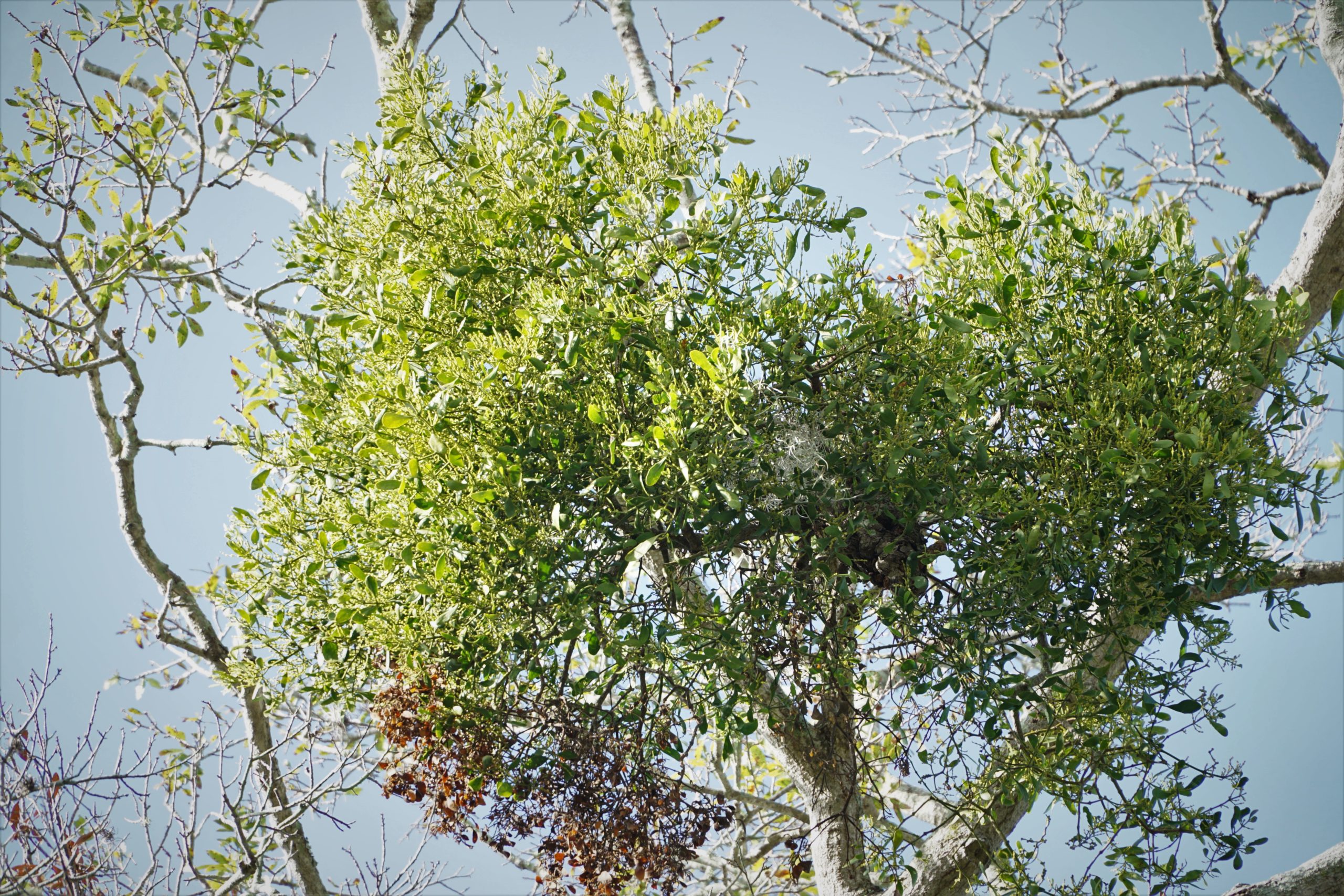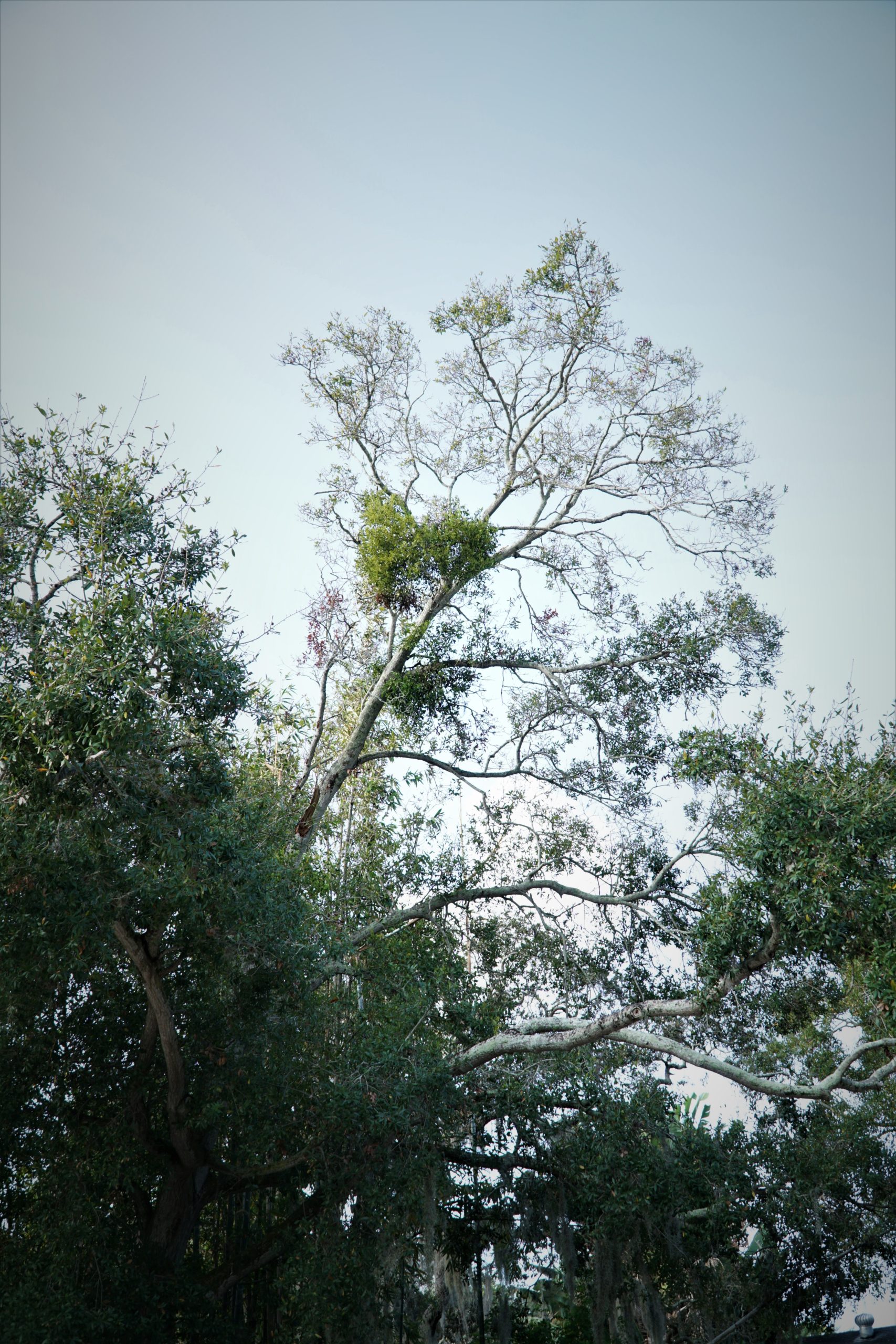 Mistletoe has had a variety of meanings and uses throughout many different times and cultures, including the current holiday tradition of kissing under the mistletoe. Last year, one of Selby Gardens’ staff members found mistletoe plants growing high in a laurel oak tree at the downtown campus (see photos below); and with the holidays fast approaching, we thought this was the perfect opportunity to share more details about this charismatic plant. Unlike the epiphytic plants we showcase here at Selby Gardens, mistletoe is a parasite.
Mistletoe has had a variety of meanings and uses throughout many different times and cultures, including the current holiday tradition of kissing under the mistletoe. Last year, one of Selby Gardens’ staff members found mistletoe plants growing high in a laurel oak tree at the downtown campus (see photos below); and with the holidays fast approaching, we thought this was the perfect opportunity to share more details about this charismatic plant. Unlike the epiphytic plants we showcase here at Selby Gardens, mistletoe is a parasite.
Epiphytes are plants that live on another plant or tree, but do not draw nutrients from it. Parasitic plants, on the other hand, take nutrients from their host as they grow on it, sometimes causing the death of the host plant if they are too numerous. Mistletoe is specifically classified as an “obligate stem hemiparasite”; it is completely dependent on the host’s branches to grow, survive, and reproduce, but because it still contains green chlorophyll (unlike some truly parasitic plants), it can make its own food from sunlight to supplement the water and nutrients it takes from the host.
Mistletoe is commonly found growing in oak trees here in Florida, and is easiest to see during the winter months when the trees are bare or nearly so. The plant spreads when birds eat the viscous white berries or drupes, and then deposit the seeds onto other branches and trees in their droppings. When the seeds germinate, they produce an elongated radicle that acts as a holdfast before producing haustoria, root-like structures that penetrate the bark and cambium of the host tree and draw water and nutrients from the tree’s transport system of xylem and phloem.
 The Old English name “mistletoe” originally referred to the species Viscum album, or common mistletoe, which can be found from the British Isles right across much of Eurasia. The term “mistletoe” was eventually applied by plant taxonomists to some 1,300 other plant species with similar parasitic habits around the world, mainly in the plant families Santalaceae, as well as the Loranthaceae and Misodendraceae. The Amazon rainforest is the center of mistletoe diversity, while the U.S. mainland and Canada are home to 30 species, predominantly in the genus Phoradendron. In Florida we have just two species, including the widespread Phoradendron leucarpum (eastern mistletoe), which can be found throughout much of the state and the eastern U.S., as well as the critically endangered Phoradendron rubrum (mahogany mistletoe), which is only found in Miami and the Florida Keys, as well as the nearby Bahamas and Cuba. Both species are closely related to the common mistletoe of Eurasia, and they share the same family (Santalaceae).
The Old English name “mistletoe” originally referred to the species Viscum album, or common mistletoe, which can be found from the British Isles right across much of Eurasia. The term “mistletoe” was eventually applied by plant taxonomists to some 1,300 other plant species with similar parasitic habits around the world, mainly in the plant families Santalaceae, as well as the Loranthaceae and Misodendraceae. The Amazon rainforest is the center of mistletoe diversity, while the U.S. mainland and Canada are home to 30 species, predominantly in the genus Phoradendron. In Florida we have just two species, including the widespread Phoradendron leucarpum (eastern mistletoe), which can be found throughout much of the state and the eastern U.S., as well as the critically endangered Phoradendron rubrum (mahogany mistletoe), which is only found in Miami and the Florida Keys, as well as the nearby Bahamas and Cuba. Both species are closely related to the common mistletoe of Eurasia, and they share the same family (Santalaceae).
 Mistletoe was used as an herbal remedy by the ancient Greeks, Romans, and Native Americans, and it was revered as an evergreen symbol of fertility and rebirth by the Celtic druids, but the romantic tradition of the kissing under the plant is linked to folklore from Norse mythology. In this allegorical myth, mistletoe symbolizes “evergreen” hope kept alive in the dead of winter before the restorative resurrection of green plant life that arrives in the spring. Keep on the lookout for this celebrated plant on oak trees around Florida and in your own backyards during the winter months.
Mistletoe was used as an herbal remedy by the ancient Greeks, Romans, and Native Americans, and it was revered as an evergreen symbol of fertility and rebirth by the Celtic druids, but the romantic tradition of the kissing under the plant is linked to folklore from Norse mythology. In this allegorical myth, mistletoe symbolizes “evergreen” hope kept alive in the dead of winter before the restorative resurrection of green plant life that arrives in the spring. Keep on the lookout for this celebrated plant on oak trees around Florida and in your own backyards during the winter months.
Written by: Shawn McCourt, Ph.D. and Lauren Meyer
Sources:
Andrews, Evan. “Why Do We Kiss under the Mistletoe?” History.com, A&E Television Networks, 24 Dec. 2013, https://www.history.com/news/why-do-we-kiss-under-the-mistletoe.
Sweetser, Robin. “Why Do We Kiss Under the Mistletoe?” Old Farmer’s Almanac, 16 Dec. 2019, https://www.almanac.com/news/gardening/gardening-advice/why-do-we-kiss-under-mistletoe.
About Images:
Eastern mistletoe (Phoradendron leucarpum) found in 2019 in a laurel oak at Selby’s downtown campus. Photos by Lauren Meyer.
Image of vintage French postcard sourced from www.thegraphicsfairy.com
